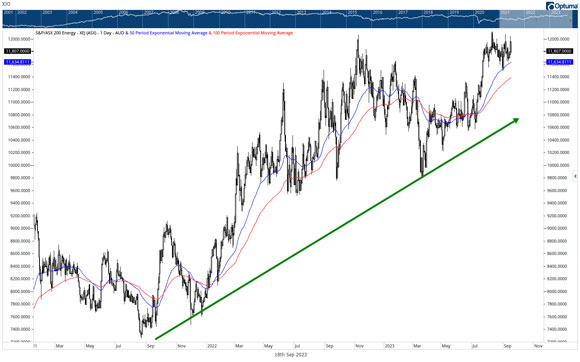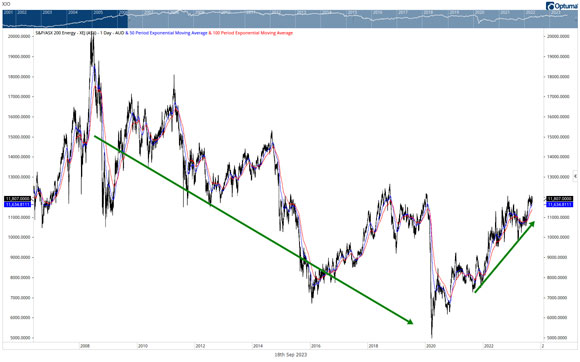As longer-term readers will know, I’ve been bullish on energy stocks since 2020/21. Since that time, they’ve been a real contrarian investment. That is, generally disliked and overlooked by the broader market.
While that is still the case, it’s less than it was. Investors are starting to wake up to the fact that traditional energy sources are going to be around for a long time.
Investors are looking at the economics of this energy transition. They realise that 2+2 = 4. But the government is trying to convince everyone that 2+2 = 5. To see through the spin (‘renewables are the cheapest form of energy’) you just have to look elsewhere in the world.
You may have heard of Germany’s ‘Energiewende’. It’s the name given to Germany’s energy transition. It began in 2000, well before most other developed nations. So it gives us a little window into the future in Australia.
At the 20-year anniversary of this transition, energy legend Vaclav Smil wrote a brief article summarising the results of ‘energiewende’:
‘During the past two decades, the Energiewende has been praised as an innovative miracle that will inexorably lead to a completely green Germany and criticized as an expensive, poorly coordinated overreach. I will merely present the facts.
‘The initiative has been expensive, and it has made a major difference. In 2000, 6.6 percent of Germany’s electricity came from renewable sources; in 2019, the share reached 41.1 percent. In 2000, Germany had an installed capacity of 121 gigawatts and it generated 577 terawatt-hours, which is 54 percent as much as it theoretically could have done (that is, 54 percent was its capacity factor). In 2019, the country produced just 5 percent more (607 TWh), but its installed capacity was 80 percent higher (218.1 GW) because it now had two generating systems.’
That is, installed capacity grew significantly because it had to run a renewables system and a fossil fuelled back-up system in tandem.
‘The new system, using intermittent power from wind and solar, accounted for 110 GW, nearly 50 percent of all installed capacity in 2019, but operated with a capacity factor of just 20 percent. (That included a mere 10 percent for solar, which is hardly surprising, given that large parts of the country are as cloudy as Seattle.) The old system stood alongside it, almost intact, retaining nearly 85 percent of net generating capacity in 2019. Germany needs to keep the old system in order to meet demand on cloudy and calm days and to produce nearly half of total demand. In consequence, the capacity factor of this sector is also low.
‘It costs Germany a great deal to maintain such an excess of installed power. The average cost of electricity for German households has doubled since 2000. By 2019, households had to pay 34 U.S. cents per kilowatt-hour, compared to 22 cents per kilowatt-hour in France and 13 cents in the United States.
‘We can measure just how far the Energiewende has pushed Germany toward the ultimate goal of decarbonization. In 2000, the country derived nearly 84 percent of its total primary energy from fossil fuels; this share fell to about 78 percent in 2019. If continued, this rate of decline would leave fossil fuels still providing nearly 70 percent of the country’s primary energy supply in 2050.’
That’s a lot of investment and effort over 20 years for bringing total primary energy usage from fossil fuels down from 84% to 78%.
How much investment? I couldn’t find any firm numbers on it, although there are a lot of estimates. The proof is in the pudding though, and clearly German electricity costs are among the highest in Europe.
According to Statista, in 2022 Denmark and Italy had the highest electricity costs in Europe, at US$0.57 per kilowatt hour, followed by Germany with US$0.55. That may reflect Russia/Ukraine war effects, but even before that, Germany’s electricity bills were much higher than the EU average.
But don’t worry — Chris Bowen says that wind and solar are the cheapest forms of energy. Just don’t hold your breath waiting for your energy bills to come down.
So while we might spend hundreds of billions on our own transition, our economy (and the global economy in general) will still be heavily dependent on fossil fuels.
Which means traditional energy stocks should be an ongoing part of your portfolio mix for years to come.
How long?
Well, take a look at the following chart. It shows the ASX200 energy index trending steadily higher since late 2021. It’s had some sharp corrections along the way, but the broad trend has been up.
|
|
|
Source: Optuma |
But I would argue this trend is still in its infancy. Yes, there will continue to be corrections along the way, some deep and scary. You might feel like dumping your shares even.
But this next chart provides some perspective. It’s a much longer-term view of the same chart. It shows the ASX200 energy index from around 2006. It peaked in 2008 and then went into a multi-year decline.
As you can see, the past few years’ gains has brought the sector back to where it was just before COVID hit. But if it’s going to get back to anywhere near its all-time highs, it still has a long way to go…
|
|
|
Source: Optuma |
That’s why I think this trend has years to play out.
Let me be clear though. It won’t be one-way traffic. There will be corrections that try to shake you out of your position. And rallies that make you want to buy at short-term tops.
So the way I suggest playing this long-term trend is to think like a contrarian. Buy on dips/corrections and take some profits on sharp rallies when it feels like EVERYONE is on board. Being long-term bullish on a sector doesn’t mean being blindly bullish.
Uranium — it’s getting a bit silly
Which is why I suggest refraining from jumping on the uranium stock price bandwagon right now. Again, the long-term future for nuclear and uranium is extremely bullish. But right now, that bullishness is all in the price. Investors are queuing up to get in the door.
It’s all getting a bit silly, as you can see in the chart of the Betashares Global Uranium ETF [ASX:URNM]. In the past week the price has gone vertical. The RSI momentum indicator is nearly off the charts!
|
|
|
Source: Optuma |
There is going to be a sharp correction soon enough and the latecomers will be badly underwater. Remember, this is a long-term trend we’re looking at here. There is no need to chase short-term rallies on fear of missing out.
I’m keeping a close eye on the chart, and I’ll let you know when might be a good opportunity to take a position. It could be a few weeks, or a few months. Patience is the key.
What’s certain though is that the energy debate, and the demand for traditional energy, isn’t going away. Net Zero is a pipedream and the more we try to achieve it, the deeper the economic hole we’re digging for ourselves.
Why wait for recession when there’s already one to take advantage of?
It’s often said that the best time to invest is in a recession. It’s a time when maximum fear and uncertainty creates low prices. If you can withstand that uncertainty, buying low generally creates the opportunity for good long-term gains.
But ‘buying in a recession’ is never straightforward. That’s because the market will discount (price in) a recession well before the newspapers confirm its existence. And when you’re reading about it, it’s generally too late. The market has moved on and started to price in a recovery.
But there are times when you get recession prices during a known recession. And that’s the situation I’ve got for you…
For access to this entire report — including the buying instructions for the stock Greg is talking about — take out a subscription to Greg’s Fat Tail Investment Advisory.
As Greg outlines above, as well as in his most controversial ‘NOT ZERO’ video, this renewable energy transition has economy-breaking faults that proponents aren’t acknowledging. But the market is starting to clue on...and that could hand you one of the biggest investment opportunities of your life if you’re in the know.
Watch ‘NOT ZERO’ here if you haven’t already, and consider taking up this special offer to join Fat Tail Investment Advisory today.
Regards,
 |
Greg Canavan,
Editor, Money Morning




